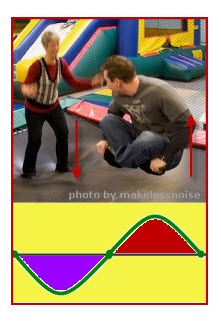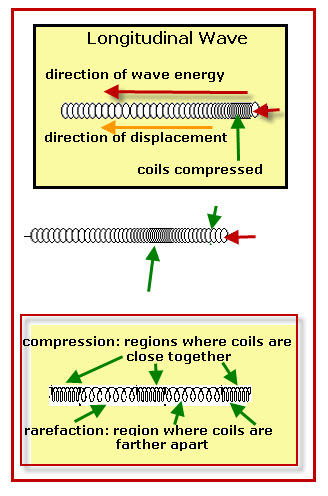
There are two types of mechanical waves: transverse and longitudinal. A type of mechanical wave energy that causes the medium (material) through which is travels to be disturbed. The movement of the medium is in a direction that is perpendicular (at right angle) to the direction of the wave. In other words, if the energy is moving horizontally, the medium is displaced in an up and down direction.
Transverse Wave: A mechanical wave is a type of energy that disturbs the medium through which it travels. This means that the energy requires a material in order for the energy to be transmitted from one place to another.
In the photo a lady has jumped onto a trampoline causing the surface of the trampoline to be pushed down in the area where she landed. In other words, the surface of the trampoline was disturbed and the the amplitude of this disturbance is equal to how far down the surface was pressed. The results is a connecting spot, under where the man was sitting on the trampoline suddenly rises with enough energy to throw the man up into the air as shown. The stretched surface under the lady’s feet will spring back into its original shape with enough energy to throw the lady upward for a short distance. If the man falls so that he hits the trampoline at the right time he will push the surface down which will add to the energy throwing the lady upward.
Longitudinal Wave: A type of mechanical wave energy that causes the medium through which it travels to be disturbed. The movement of the medium is in the same direction as is the direction of energy.
 In the diagram, a slinky is used to demonstrate a longitudinal wave. The energy is moving to the left as will be the displacement of the coils. As shown the coil is laying horizontally with some of the coils squeezed together at the right end.
In the diagram, a slinky is used to demonstrate a longitudinal wave. The energy is moving to the left as will be the displacement of the coils. As shown the coil is laying horizontally with some of the coils squeezed together at the right end.
Assuming that the ends of the slinky are secured, when the compressed coils are released, they will spread out pushing the coils in front of them together–compressing them. Shown in the second diagram of the slinky.
In the bottom diagram, the parts of a longitudinal wave are identified and defined. Since the slinky is secured at each end the wave energy bounces back and forth from one end to the other.
 |
Physics For Every Kids |